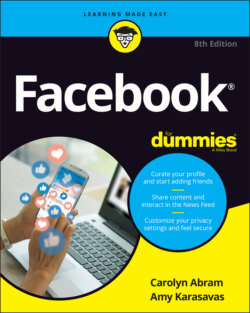Читать книгу Facebook For Dummies - Carolyn Abram - Страница 74
Anatomy of a News Feed post
ОглавлениеFigure 4-1 shows a sample News Feed post. In this case, it’s a status update from a friend. In the Facebook world, a status update refers to any text people post that answers the question “What’s on your mind?”
FIGURE 4-1: Just your average status update.
Even in this simple example, there are lots of things to pay attention to. However, when you’re scanning News Feed, you’ll probably first pick up on “who” and “what”:
Name and profile picture: The first part of any post is who it’s about or who wrote it. Both the name and picture are links to that person’s timeline. In addition, if you hover the mouse cursor over a person’s name, you’ll see a miniaturized preview of the person's timeline with information about your relationship (you are friends and following her, in most cases) as well as a button you can click to message her. Hovering the mouse cursor over any bolded text in a News Feed post generates a preview for a timeline, Page, or interest with specific buttons for adding friends, liking, or following.
Content: The content section of a News Feed post is the most variable element. You might see a preview of an article, or a video, or a photo album. It could also be a location where someone has checked in, or marked her location (such as the Golden Gate Bridge or her local coffee shop) when she posted. The content is the part of the post that is the most important; it’s the reason for the post existing. In Figure 4-1, the content is a status update about Kara’s houseplants.
After you have the basics and who and what, you can focus on some of the other details to be found in a simple status update:
Feeling/activity info: Not every status includes this, but Facebook provides a list of emotions and activities that can be appended to any status update or post. In this case, the emoji (and words) depict that Kara was “feeling hopeful” when she wrote this status update.
Tags: Tags are a way of marking who or what is with you when you post something to Facebook. You might tag a person who is with you when you write a post, or you might tag a TV show you're watching. Tags in posts are displayed as links in blue or bold text. You can hover the mouse cursor over these tags to view more info about that person, Page, place, or thing. In the status update shown in Figure 4-1, Kara Lynne tagged Amy.
Timestamp: The little grey text near the profile photo in the post tells you how long ago this post was added.
Privacy info: The grey icon next to the timestamp represents the privacy of that post. Hover the mouse cursor over the icon to see who else can see the post. Usually posts are visible either to everyone (Public) or just to that person’s friends.
Like, Comment, and (Share): These links allow you to interact with your friends about the content they’ve posted. In addition, you can see how many people have already liked a post, and you can see any comments that have been made below the post itself. You might also see a text box next to your profile picture prompting you to “Write a comment ….” Commenting, liking, and sharing are covered in more detail in the “Interacting with Your News Feed” section, later in this chapter.
